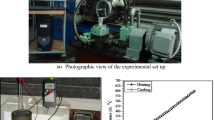Abstract
In this paper, a new attempt has been made in the area of tool-based micromachining for automated, non-contact, and flexible prediction of quality responses such as average surface roughness (R a), tool wear ratio (TWR) and metal removal rate (MRR) of micro-turned miniaturized parts through a machine vision system (MVS) which is integrated with an adaptive neuro-fuzzy inference system (ANFIS). The images of machined surface grabbed by the MVS could be extracted using the algorithm developed in this work, to get the features of image texture [average gray level (G a)]. This work presents an area-based surface characterization technique which applies the basic light scattering principles used in other optimal optical measurement systems. These principles are applied in a novel fashion which is especially suitable for in-process prediction and control. The main objective of this study is to design an ANFIS for estimation of R a, TWR, and MRR in micro-turning process. Cutting speed (S), feed rate (F), depth of cut (D), G a were taken as input parameters and R a, TWR, MRR as the output parameters. The results obtained from the ANFIS model were compared with experimental values. It is found that the predicted values of the responses are in good agreement with the experimental values.
Similar content being viewed by others
References
Masuzawa T.: State of the art of micromachining. Ann. CIRP 49(2), 473–488 (2000)
Hesselbach J., Raatz A., Wreg J.: International state of the art of micro production technology. Prod. Eng. 11(1), 29–36 (2004)
Madou M.J.: Fundamentals of Micro fabrication. CRC Press, Ohio (1997)
Corbett J., McKeon P.A., Peggs G.N., Whatmore R.: Nanotechnology, international developments and emerging products. Ann. CIRP 49(3), 473–478 (2000)
Gowri S., Ranjith Kumar P., Vijayaraj R., Balan A.S.S.: Micro machining: technology for the future. Int. J. Mater. Struct. Integr. 19(1), 161–179 (2007)
Choudhury I.A., EI-Baradie M.A.: Surface roughness prediction in the turning of high-strength steel by factorial design of experiments. J. Mater. Process. Technol. 67(1–3), 55–61 (1997)
Oezel T., Karpat Y.: Predictive modeling of surface roughness and tool wear in hard turning using regression and neural networks. Int. J. Mach. Tools Manuf. 45(4–5), 467–479 (2005)
Weulel H., Hüntrup V., Tritschler H.: Micro-cutting of steel to meet new requirements in miniaturization. CIRP Ann. 50(1), 61–64 (2001)
Kim J., Kang Y.: High-spend machining of aluminium using diamond end mills. Int. J. Mach. Tools Manuf. 37(8), 1155–1165 (1997)
Torres C., Heaney P., Sumant A., Hamilton M., Carpick R., Pfefferkorn F.: Analyzing the performance of diamond coated micro end mills. Int. J. Mach. Tools Manuf. 49(7–8), 599–612 (2009)
Ho S.Y., Lee K.C., Chen S.S. et al.: Accurate modeling and prediction of surface roughness by computer vision in turning operations using an adaptive neuro-fuzzy inference system. Int. J. Mach. Tools Manuf. 42(13), 1441–1446 (2002)
Lee B.Y., Yu S.F., Juan H.: The model of surface roughness inspection by vision system in turning. Mechatronics 14(1), 129–141 (2004)
Priya P., Ramamoorthy B.: The influence of component inclination on surface finish evaluation using digital image processing. Int. J. Mach. Tools Manuf. 47(3–4), 570–579 (2007)
Shahabi H.H., Ratnam M.M.: Non-contact roughness measurement of turned parts using machine vision. Int. J. Adv. Manuf. Technol. 46(1–4), 275–284 (2010)
Lo S.P.: An adaptive-network based fuzzy inference system for prediction of work piece surface roughness in end milling. J. Mater. Process. Technol. 142(3), 665–675 (2003)
Roy S.S.: An adaptive network-based fuzzy approach for prediction of surface roughness in CNC End milling. J. Sci. Ind. Res. 65, 329–334 (2006)
Samhouri M.S., Surgenor B.W.: Surface roughness in grinding: on-line prediction with adaptive neuro-fuzzy inference system. Trans NAMRI/SME 33, 24–27 (2005)
Kumanan S., Jesuthanam C.P., Kumar R.A.: Application of multiple regression and adaptive neuro fuzzy inference system for the prediction of surface roughness. Int. J. Adv. Manuf. Technol. 35(7–8), 778–788 (2008)
Ho W.H., Tsai J.T., Lin B.T. et al.: Adaptive network-based fuzzy inference system for prediction of surface roughness in end milling process using hybrid Taguchi-genetic learning algorithm. Expert Syst. Appl. 36(2), 3216–3222 (2009)
Samantha B.: Surface roughness prediction in machining using soft computing. Int. J. Comput. Integra. Manuf. 22(3), 257–266 (2009)
Dong M.G., Wang N.: Adaptive network-based fuzzy inference system with leave-one-out cross-validation approach for prediction of surface roughness. Appl. Math. Model. 35(3), 1024–1035 (2011)
Jang J.S.R, Sun C.T., Mizutani E.: Neuro Fuzzy Logic and Soft Computing. Prentice-Hall, Englewood cliffs (2004)
Author information
Authors and Affiliations
Corresponding author
Rights and permissions
About this article
Cite this article
Palani, S., Natarajan, U. & Chellamalai, M. On-line prediction of micro-turning multi-response variables by machine vision system using adaptive neuro-fuzzy inference system (ANFIS). Machine Vision and Applications 24, 19–32 (2013). https://doi.org/10.1007/s00138-011-0378-0
Received:
Revised:
Accepted:
Published:
Issue Date:
DOI: https://doi.org/10.1007/s00138-011-0378-0




